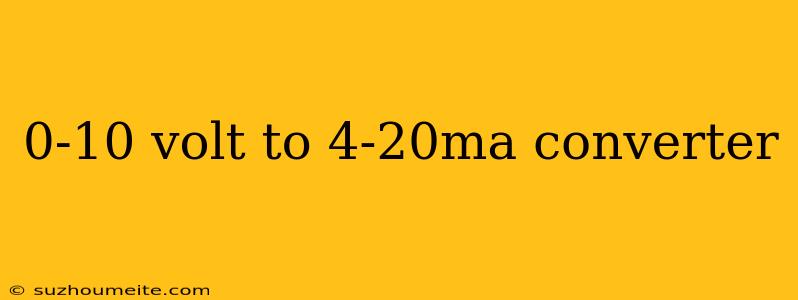0-10 Volt to 4-20mA Converter: A Comprehensive Guide
Introduction
In industrial automation, measuring and controlling physical parameters such as pressure, temperature, and flow rate is crucial. These parameters are often measured using sensors that output an electrical signal, which then needs to be converted into a format that can be understood and utilized by control systems. One such conversion is from 0-10 Volt to 4-20mA, which is a widely used protocol in industrial automation. In this article, we will delve into the world of 0-10 Volt to 4-20mA converters, their working principles, and applications.
What is a 0-10 Volt to 4-20mA Converter?
A 0-10 Volt to 4-20mA converter is an electronic device that converts a 0-10 Volt analog signal into a 4-20mA current signal. The input signal, typically from a sensor or a transmitter, is amplified and conditioned to produce a current signal that is proportional to the input voltage. This current signal is then transmitted over a two-wire connection to a control system, such as a PLC or DCS, for further processing and control.
Working Principle
The working principle of a 0-10 Volt to 4-20mA converter is based on the concept of current loop transmission. The converter consists of an amplifier, a voltage-to-current converter, and a current loop driver. Here's a simplified explanation of the process:
- Amplification: The 0-10 Volt input signal is amplified to a level that is sufficient to drive the current loop.
- Voltage-to-Current Conversion: The amplified voltage signal is converted into a current signal using a voltage-to-current converter.
- Current Loop Driver: The current signal is then transmitted over a two-wire connection to the control system.
Applications
0-10 Volt to 4-20mA converters have a wide range of applications in industrial automation, including:
- Process Control: Measuring and controlling process variables such as pressure, temperature, and flow rate.
- Industrial Automation: Interfacing with sensors and transmitters to transmit signals to control systems.
- Machine Automation: Monitoring and controlling machine performance and parameters.
Advantages
- Noise Immunity: Current signals are more resistant to electromagnetic interference (EMI) and radio-frequency interference (RFI) than voltage signals.
- Long Distance Transmission: Current signals can be transmitted over long distances without significant attenuation.
- Simple Wiring: Two-wire connection simplifies wiring and reduces installation costs.
Conclusion
In conclusion, 0-10 Volt to 4-20mA converters play a crucial role in industrial automation by enabling the transmission of analog signals over long distances without significant attenuation. Their applications are diverse, ranging from process control to machine automation. By understanding the working principle and advantages of these converters, engineers and technicians can design and implement reliable and efficient control systems.
